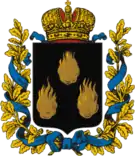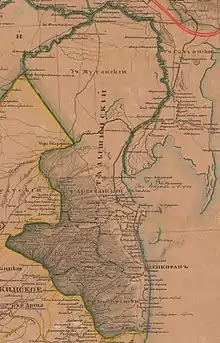Lenkoran uezd
The Lenkoran uezd[lower-alpha 1] or Talysh uezd was a county (uezd) within the Baku Governorate of the Russian Empire, and then of the Azerbaijan Democratic Republic and the Azerbaijan SSR until its formal abolishment in 1929.[1][2] The county was located on the southern part of the governorate, bordering Caspian sea to the east, Javad uezd to the north, and Iran to the southwest.[3] The administrative centre of the county was the city of Lenkoran (present-day Lankaran).
Lenkoran uezd
Ленкоранскій уѣздъ | |
|---|---|
 Coat of arms | |
 Location in the Baku Governorate | |
| Country | Russian Empire |
| Viceroyalty | Caucasus |
| Governorate | Baku |
| Established | 1840 |
| Abolished | 1929 |
| Capital | Lenkoran (present-day Lankaran) |
| Area | |
| • Total | 5,379.48 km2 (2,077.03 sq mi) |
| Population (1916) | |
| • Total | 203,319 |
| • Density | 38/km2 (98/sq mi) |
| • Urban | 8.76% |
| • Rural | 91.24% |
Administrative divisions
The subcounties (uchastoks) of the Lenkoran uezd in 1912 were as follows:[4]
| Name | 1912 population | Area |
|---|---|---|
| Arkevanskiy uchastok (Аркеванскій участокъ) | 33,413 | 700.16 square versts (796.83 km2; 307.66 sq mi) |
| Zuvanskiy uchastok (Зувандскій участокъ) | 30,058 | 1,198.15 square versts (1,363.57 km2; 526.48 sq mi) |
| Lenkoranskiy uchastok (Ленкоранскій участокъ) | 30,605 | 1,180.53 square versts (1,343.52 km2; 518.73 sq mi) |
| Sebidazhskiy uchastok (Себидажскій участокъ) | 40,652 | 1,648.04 square versts (1,875.57 km2; 724.16 sq mi) |
| Astarinskiy raion (Астаринскій раіонъ) | 6,730 | – |
History

The county was established on 10 April 1840 on the basis of Talysh Khanate. It was initially made a part of the Caspian oblast on 1840, and later renamed Lenkoran uezd in 1845[2] and made part of the Shamakhi Governorate in 1846.[5] Due to an earthquake in Shamakhi in 1859, the centre of the Shamakhi Governorate was moved from Shamakhi to Baku and the governorate was renamed Baku Governorate.[6][2]
In 1918, after the collapse of the Russian Empire, Azerbaijan Democratic Republic gained brief independence. Bolshevik Baku Commune was in control of Baku at the time, and they were trying to spread their control over other places in Azerbaijan, such as Lenkoran uezd. This led to the creation of the Mughan Soviet Republic in the territories of the Lenkoran uezd on 25 April 1919, but the republic was short-lived and it collapsed 3 months later, on 27 July 1919. Subsequently, the county was integrated into Azerbaijan Democratic Republic.[7]
After the Red Army invasion of Azerbaijan in 1920, Azerbaijan was integrated into the Soviet Union and the county was abolished by Soviet authorities in 1929.
Demographics
According to the "Code of statistical data on the population of the Transcaucasian region" from 1886, the population of the county was 109,340 people, of which 50,887 (46.5%) Talysh, 50,510 (46.2%) were Azerbaijanis, 7,634 were Russians and 273 (0.2%) were Armenians.[8]
Russian Empire Census
According to the Russian Empire Census, the Lenkoran uezd had a population of 130,987 on 28 January [O.S. 15 January] 1897, including 72,492 men and 58,495 women. The majority of the population indicated Tatar[lower-alpha 2] to be their mother tongue, with significant Talysh and Russian speaking minorities.[11]
| Language | Native speakers | % |
|---|---|---|
| Tatar[lower-alpha 2] | 84,725 | 64.68 |
| Talysh | 34,991 | 26.71 |
| Russian | 9,481 | 7.24 |
| Armenian | 483 | 0.37 |
| Ukrainian | 243 | 0.19 |
| Jewish | 207 | 0.16 |
| Polish | 205 | 0.16 |
| Mordovian | 169 | 0.13 |
| German | 132 | 0.10 |
| Persian | 89 | 0.07 |
| Turkish | 82 | 0.06 |
| Tat | 74 | 0.06 |
| Georgian | 17 | 0.01 |
| Avar-Andean | 14 | 0.01 |
| Greek | 9 | 0.01 |
| Lithuanian | 5 | 0.00 |
| Belarusian | 4 | 0.00 |
| Kyurin | 4 | 0.00 |
| Swedish | 2 | 0.00 |
| Kazi-Kumukh | 1 | 0.00 |
| Other | 50 | 0.04 |
| TOTAL | 130,987 | 100.00 |
The significant share reduction of the Talysh population in comparison with the data of 1886 cannot be explained by natural demographic processes and is a consequence of the registration of Iranian-speaking Talysh as Azerbaijanis (“Caucasian Tatars”). After 1886, the Talysh did not move out and did not die out. It is clear that a significant part of the Talysh, on the basis of their language, are ranked among the Azerbaijanis (“Caucasian Tatars”).[12]
Kavkazskiy kalendar
According to the 1917 publication of Kavkazskiy kalendar, the Lenkoran uezd had a population of 203,319 on 14 January [O.S. 1 January] 1916, including 106,891 men and 96,428 women, 195,247 of whom were the permanent population, and 8,072 were temporary residents:[13]
| Nationality | Urban | Rural | TOTAL | |||
|---|---|---|---|---|---|---|
| Number | % | Number | % | Number | % | |
| Shia Muslims[lower-alpha 3] | 15,147 | 85.09 | 161,815 | 87.22 | 176,962 | 87.04 |
| Russians | 1,874 | 10.53 | 16,206 | 8.74 | 18,080 | 8.89 |
| Sunni Muslims[lower-alpha 4] | 82 | 0.46 | 7,086 | 3.82 | 7,168 | 3.53 |
| Armenians | 550 | 3.09 | 286 | 0.15 | 836 | 0.41 |
| Jews | 99 | 0.56 | 118 | 0.06 | 217 | 0.11 |
| Other Europeans | 49 | 0.28 | 7 | 0.00 | 56 | 0.03 |
| TOTAL | 17,801 | 100.00 | 185,518 | 100.00 | 203,319 | 100.00 |
Soviet census (1926)
In 1926, the population of the county rose to 208,479.[15]
Notes
-
- Russian: Ленкора́нскій уѣ́здъ, romanized: Lenkoránsky uyézd
- Azerbaijani: لنکران قضاسی, romanized: Lankarān qaz̤āsı
- Before 1918, Azerbaijanis were generally known as "Tatars". This term, employed by the Russians, referred to Turkic-speaking Muslims of the South Caucasus. After 1918, with the establishment of the Azerbaijan Democratic Republic and "especially during the Soviet era", the Tatar group identified itself as "Azerbaijani".[9][10]
- Primarily Tatars.[14]
- Primarily Turco-Tatars.[14]
References
- Исмаилов Э.Э. (2001). Генеология Талышинских-Талышхановых. Абилов, Зейналов и сыновья. p. 10. ISBN 5-87459-246-6.
- Чичкин А.А. (2013). Друзья и враги за Кавказским хребтом. Москва: Вече. p. 27. ISBN 978-5-4444-0737-0.
- Tsutsiev 2014, p. 59.
- Кавказский календарь на 1913 год, pp. 140–143.
- Исмаилов Э.Э. (2001). Генеология Талышинских-Талышхановых. Баку. p. 10. ISBN 5-87459-246-6.
{{cite book}}: CS1 maint: location missing publisher (link) - "Administrative Territorial Division" (PDF). preslib.az. p. 9.
- Smele, Jonathan D. (2015). Historical Dictionary of the Russian Civil Wars, 1916-1926. Rowman & Littlefield. p. 771. ISBN 9781442252813.
- Закавказский статистический комитет. Свод статистических данных о населении Закавказскаго края, извлеченных из посемейных списков 1886 г. / Главноначальствующий гражданскою частию на Кавказе. — Тифлис: Тип. И. Мартиросиянца, 1893, 1893. — С. 337. — 487 с.
- Bournoutian 2018, p. 35 (note 25).
- Tsutsiev 2014, p. 50.
- "Первая всеобщая перепись населения Российской Империи 1897 г. Распределение населения по родному языку и уездам Российской Империи кроме губерний Европейской России" (in Russian). Демоскоп.
- Г.Ф.ЧУРСИН. ТАЛЫШИ. — Известия кавказского историко-археологического общества. ЭТНОГРАФИЧЕСКИЕ ЗАМЕТКИ.. — Тифлис, 1926. — С. 15-45.
- Кавказский календарь на 1917 год, pp. 178–181.
- Hovannisian 1971, p. 67.
- "Population of Lankaran Uyezd". Demoskop Weekly.
Bibliography
- Bournoutian, George A. (2018). Armenia and Imperial Decline: The Yerevan Province, 1900–1914. Milton Park, Abingdon, Oxon: Routledge. ISBN 978-1-351-06260-2. OCLC 1037283914.
- Hovannisian, Richard G. (1971). The Republic of Armenia: The First Year, 1918–1919. Vol. 1. Berkeley: University of California Press. ISBN 978-0520019843.
- Кавказский календарь на 1913 год [Caucasian calendar for 1913] (in Russian) (68th ed.). Tiflis: Tipografiya kantselyarii Ye.I.V. na Kavkaze, kazenny dom. 1913. Archived from the original on 19 April 2022.
- Кавказский календарь на 1917 год [Caucasian calendar for 1917] (in Russian) (72nd ed.). Tiflis: Tipografiya kantselyarii Ye.I.V. na Kavkaze, kazenny dom. 1917. Archived from the original on 4 November 2021.
- Tsutsiev, Arthur (2014). Atlas of the Ethno-Political History of the Caucasus (PDF). Translated by Nora Seligman Favorov. New Haven: Yale University Press. ISBN 9780300153088. Archived (PDF) from the original on 17 June 2023.